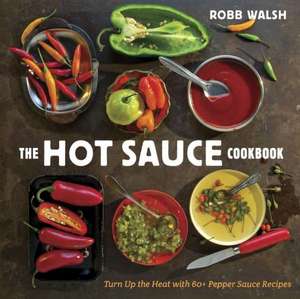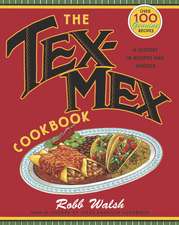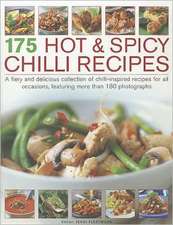The Hot Sauce Cookbook
Autor Robb Walshen Limba Engleză Hardback – 30 mai 2013
Here’s a cookbook that really packs a punch. With dozens of recipes for homemade pepper sauces and salsas—including riffs on classic brands like Frank’s RedHot, Texas Pete, Crystal, and Sriracha—plus step-by-step instructions for fermenting your own pepper mash, The Hot Sauce Cookbook will leave you amazed by the fire and vibrancy of your homemade sauces. Recipes for Meso-american salsas, Indonesian sambal, and Ethiopian berbere showcase the sweeping history and range of hot sauces around the world. If your taste buds can handle it, Walsh also serves up more than fifty recipes for spice-centric dishes—including Pickapeppa Pot Roast, the Original Buffalo Wing, Mexican Micheladas, and more. Whether you’re a die-hard chilehead or just a DIY-type in search of a new pantry project, your cooking is sure to climb up the Scoville scale with The Hot Sauce Cookbook.
Preț: 77.47 lei
Preț vechi: 90.57 lei
-14% Nou
Puncte Express: 116
Preț estimativ în valută:
14.83€ • 15.46$ • 12.32£
14.83€ • 15.46$ • 12.32£
Carte disponibilă
Livrare economică 28 februarie-07 martie
Livrare express 13-19 februarie pentru 41.78 lei
Preluare comenzi: 021 569.72.76
Specificații
ISBN-13: 9781607744269
ISBN-10: 1607744260
Pagini: 143
Ilustrații: 30 Colour Photos
Dimensiuni: 185 x 188 x 17 mm
Greutate: 0.45 kg
Editura: Ten Speed Press
ISBN-10: 1607744260
Pagini: 143
Ilustrații: 30 Colour Photos
Dimensiuni: 185 x 188 x 17 mm
Greutate: 0.45 kg
Editura: Ten Speed Press
Notă biografică
A three-time James Beard award winner, ROBB WALSH is the author of ten previous books, including Texas Eats and The Tex-Mex Cookbook. As the former editor-in-chief of Chile Pepper magazine and the founder of the annual Austin Hot Sauce Festival, Walsh is recognized as one of the foremost hot sauce authorities in the country. Visit www.robbwalsh.com.
Extras
Introduction
Salsa surpassed ketchup, newspaper columnists, sociologists, and grocery industry gurus marked it as a major milestone, an indicator of irreversible changes in the ethnic makeup of our society. By 2002, the space allotted to hot sauces and salsas in the average supermarket went from a few feet of shelf space to close to an entire aisle. At the fast-food counter and the condiment station of the ballpark, hot sauce has joined ketchup and mustard in the plastic-squeeze-packet pantheon.
Business Week’s list of the twenty-five top-selling condiments in America includes six salsas and four pepper sauces. The hot parade shows no sign of letting up. The 2012 Culinary Trend Mapping Report by food-industry think tank Packaged Facts declared that hot and spicy foods were still one of the fastest growing segments of the grocery business. The researchers reported that multicultural Generation Y and the growing Asian demographic were “eager to try bigger, bolder, hot and spicy flavors in nearly every daypart, food and beverage category, and season.”
From the mainstream American point of view, hot and spicy food seems like something that’s arrived on the culinary scene in the last twenty years. But while some of the brand names might be new, the recipes for the hot sauces contained inside the bottles go back hundreds and, sometimes even thousands, of years.
This book is a casual tour of hot-sauce history, a practical guide for making it at home, and an exploration of the strange relationship between humankind and hot and spicy food.
In six chapters, we consider where hot sauce came from and where it’s going. Chapter 1 introduces some key hot sauce terminology and also describes the various peppers that are used in recipes throughout this book. In chapter 2, you’ll see how your favorite Mexican salsa recipes evolved from centuries-old Mesoamerican “chilmoles.” Chapter 3 will give you some new ideas about how to use the habanero-type chiles of the Caribbean islands, and recounts the story of the pepper sauces that made those intensely hot chiles famous. Chapter 4 follows the fortunes of the Louisiana pepper sauce moguls, and offers recipes for making your own fermented pepper sauces at home. Chapter 5 is a world tour of international hot sauces, including do-it-yourself recipes for Thai Sriracha, Ethiopian berbere, and Indonesian sambal oelek. Finally, in chapter 6 we’ll see how some of America’s top chefs are using hot sauces to raise the profile of fiery food in contemporary American cuisine.
-----------------------------------------------------
Escabeche
(Pickled Peppers)
Makes about 2 quarts or 11/2 pounds (drained)
This blend of pickled chile peppers, carrots, and onions with seasonings is a favorite condiment. You can use the pickling liquid as a pepper sauce.
2 tablespoons olive oil
1 small onion, thickly sliced
5 cloves garlic, peeled and quartered
8 cups water
15 jalapeño chiles (about 1 pound)
1 pound carrots, peeled and sliced
½ inch thick (about 2 cups)
1¼ cups cider vinegar
Pickling salt
1 teaspoon dried Mexican oregano
4 bay leaves
White vinegar
Heat the oil in a large soup pot over medium-high heat. Add the onion and sauté for 3 min-utes, then add the garlic. Continue cooking until the onions are soft, 1 to 2 minutes. Add the water and bring to a boil. Add the jalapeños and carrots and cook for 5 minutes, or until slightly softened. Add the cider vinegar, 1 tablespoon pickling salt, oregano, and bay leaves and simmer for another minute. Remove from the heat and allow to cool.
Transfer the jalapeños, carrots, and onions with a slotted spoon or tongs into sterilized glass quart-size jars (you may need several). When the cooking liquid has cooled, cover the vegetables with liquid until the jars are three-quarters full. Add 1 tablespoon pickling salt to each jar and fill to the top with white vinegar. Cap each jar tightly and store in the refrigerator for up to several months.
Salsa surpassed ketchup, newspaper columnists, sociologists, and grocery industry gurus marked it as a major milestone, an indicator of irreversible changes in the ethnic makeup of our society. By 2002, the space allotted to hot sauces and salsas in the average supermarket went from a few feet of shelf space to close to an entire aisle. At the fast-food counter and the condiment station of the ballpark, hot sauce has joined ketchup and mustard in the plastic-squeeze-packet pantheon.
Business Week’s list of the twenty-five top-selling condiments in America includes six salsas and four pepper sauces. The hot parade shows no sign of letting up. The 2012 Culinary Trend Mapping Report by food-industry think tank Packaged Facts declared that hot and spicy foods were still one of the fastest growing segments of the grocery business. The researchers reported that multicultural Generation Y and the growing Asian demographic were “eager to try bigger, bolder, hot and spicy flavors in nearly every daypart, food and beverage category, and season.”
From the mainstream American point of view, hot and spicy food seems like something that’s arrived on the culinary scene in the last twenty years. But while some of the brand names might be new, the recipes for the hot sauces contained inside the bottles go back hundreds and, sometimes even thousands, of years.
This book is a casual tour of hot-sauce history, a practical guide for making it at home, and an exploration of the strange relationship between humankind and hot and spicy food.
In six chapters, we consider where hot sauce came from and where it’s going. Chapter 1 introduces some key hot sauce terminology and also describes the various peppers that are used in recipes throughout this book. In chapter 2, you’ll see how your favorite Mexican salsa recipes evolved from centuries-old Mesoamerican “chilmoles.” Chapter 3 will give you some new ideas about how to use the habanero-type chiles of the Caribbean islands, and recounts the story of the pepper sauces that made those intensely hot chiles famous. Chapter 4 follows the fortunes of the Louisiana pepper sauce moguls, and offers recipes for making your own fermented pepper sauces at home. Chapter 5 is a world tour of international hot sauces, including do-it-yourself recipes for Thai Sriracha, Ethiopian berbere, and Indonesian sambal oelek. Finally, in chapter 6 we’ll see how some of America’s top chefs are using hot sauces to raise the profile of fiery food in contemporary American cuisine.
-----------------------------------------------------
Escabeche
(Pickled Peppers)
Makes about 2 quarts or 11/2 pounds (drained)
This blend of pickled chile peppers, carrots, and onions with seasonings is a favorite condiment. You can use the pickling liquid as a pepper sauce.
2 tablespoons olive oil
1 small onion, thickly sliced
5 cloves garlic, peeled and quartered
8 cups water
15 jalapeño chiles (about 1 pound)
1 pound carrots, peeled and sliced
½ inch thick (about 2 cups)
1¼ cups cider vinegar
Pickling salt
1 teaspoon dried Mexican oregano
4 bay leaves
White vinegar
Heat the oil in a large soup pot over medium-high heat. Add the onion and sauté for 3 min-utes, then add the garlic. Continue cooking until the onions are soft, 1 to 2 minutes. Add the water and bring to a boil. Add the jalapeños and carrots and cook for 5 minutes, or until slightly softened. Add the cider vinegar, 1 tablespoon pickling salt, oregano, and bay leaves and simmer for another minute. Remove from the heat and allow to cool.
Transfer the jalapeños, carrots, and onions with a slotted spoon or tongs into sterilized glass quart-size jars (you may need several). When the cooking liquid has cooled, cover the vegetables with liquid until the jars are three-quarters full. Add 1 tablespoon pickling salt to each jar and fill to the top with white vinegar. Cap each jar tightly and store in the refrigerator for up to several months.
Recenzii
“As a big-flavor, hot-food freak, I adore this book for its deep coverage of all things spicy. But where Walsh really shines is in his simple, DIY approach to hot sauces: Now any cook, regardless of skill level, can make their own at home.”
—Andrew Zimmern, host of Bizarre Foods with Andrew Zimmern
—Andrew Zimmern, host of Bizarre Foods with Andrew Zimmern
Cuprins
Introduction
chapter 1 Hurts So Good
Roasted Green Chiles
Escabeche (Pickled Peppers)
Fried Chiles (Chiles Toreados)
chapter 2 Mesoamerican Chilmoles
“Son of Suchilquitongo” Salsa Verde
Roasted Green Chile Sauce
Easy Mole Poblano
Chicken Enchiladas
David Garrido’s Ancho-Tomatillo Sauce
Molcajete Sauce
Pico de Gallo
Mexican Shrimp Cocktail
Michelada
Sikil Pak
Xnipec
Ensalada de Nopalitos
DIY Pace Picante Sauce
chapter 3 Island Heat
Pepper Crabs
Carib Crab Salsa
Crab Backs
Boston Beach Jerk Rub
Jerk Barbecue
Pepper Sherry
Pepper Vinegar (Pique)
Vinegar Barbecue Sauce
Caribbean Pepper Mash
Papaya Fire
Mango Salsa
Chez Francine’s Sauce Piment
Pickapeppa Pot Roast
chapter 4 Louisiana hot Sauces
Fermented Pepper Mash
Homemade Pepper Sauce
Homemade Buffalo Chicken Wings
Kevin Roberts’s Beer Wings
Trey Moran’s Ancho BBQ Sauce
Bloody Mary
Texas Pete BBQ Pork
BBQ Pork Sandwiches
Backyard Oyster Bar
chapter 5 International pepper Sauces
Spicy Peanut Sauce
Nuoc Mam Cham (Vietnamese Dipping Sauce)
Goi Cuon (Vietnamese Summer Rolls)
Homemade Sriracha Sauce
Sambal
Green Curry Paste
Green Curry Shrimp
Berbere
Doro Wat
Piri-Piri Sauce
Hot Ajvar
chapter 6 Chilehead Chefs’ Hot Sauces
Raj Dixit’s Tomato-Coriander Berbere
Raj Dixit’s Green Curry Chow-Chow
Raj Dixit’s Pineapple Pique
Zak Pelaccio’s Malaysian Chicken Wings
David Chang’s Red-Eye Mayo
Bryan Caswell’s Sriracha Citrus Remoulade
Bryan Caswell’s Shrimp with Sriracha Citrus Remoulade
Randy Clemens’s Sriracha-Sesame Fruit Salad
Chris Shepherd’s Nuoc Cham Chicken Salad
Stephan Pyles’s Shrimp Ceviche
Stephan Pyles’s Habanero Cranberry Sauce
Fire and Ice Cream
Index
chapter 1 Hurts So Good
Roasted Green Chiles
Escabeche (Pickled Peppers)
Fried Chiles (Chiles Toreados)
chapter 2 Mesoamerican Chilmoles
“Son of Suchilquitongo” Salsa Verde
Roasted Green Chile Sauce
Easy Mole Poblano
Chicken Enchiladas
David Garrido’s Ancho-Tomatillo Sauce
Molcajete Sauce
Pico de Gallo
Mexican Shrimp Cocktail
Michelada
Sikil Pak
Xnipec
Ensalada de Nopalitos
DIY Pace Picante Sauce
chapter 3 Island Heat
Pepper Crabs
Carib Crab Salsa
Crab Backs
Boston Beach Jerk Rub
Jerk Barbecue
Pepper Sherry
Pepper Vinegar (Pique)
Vinegar Barbecue Sauce
Caribbean Pepper Mash
Papaya Fire
Mango Salsa
Chez Francine’s Sauce Piment
Pickapeppa Pot Roast
chapter 4 Louisiana hot Sauces
Fermented Pepper Mash
Homemade Pepper Sauce
Homemade Buffalo Chicken Wings
Kevin Roberts’s Beer Wings
Trey Moran’s Ancho BBQ Sauce
Bloody Mary
Texas Pete BBQ Pork
BBQ Pork Sandwiches
Backyard Oyster Bar
chapter 5 International pepper Sauces
Spicy Peanut Sauce
Nuoc Mam Cham (Vietnamese Dipping Sauce)
Goi Cuon (Vietnamese Summer Rolls)
Homemade Sriracha Sauce
Sambal
Green Curry Paste
Green Curry Shrimp
Berbere
Doro Wat
Piri-Piri Sauce
Hot Ajvar
chapter 6 Chilehead Chefs’ Hot Sauces
Raj Dixit’s Tomato-Coriander Berbere
Raj Dixit’s Green Curry Chow-Chow
Raj Dixit’s Pineapple Pique
Zak Pelaccio’s Malaysian Chicken Wings
David Chang’s Red-Eye Mayo
Bryan Caswell’s Sriracha Citrus Remoulade
Bryan Caswell’s Shrimp with Sriracha Citrus Remoulade
Randy Clemens’s Sriracha-Sesame Fruit Salad
Chris Shepherd’s Nuoc Cham Chicken Salad
Stephan Pyles’s Shrimp Ceviche
Stephan Pyles’s Habanero Cranberry Sauce
Fire and Ice Cream
Index







